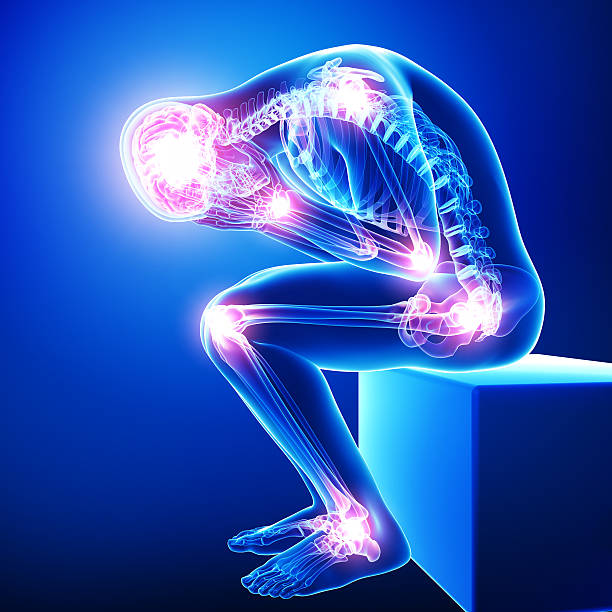Inflammation Intervention: Exploring the Top 7 Exercises for Reducing Swelling and Pain
Do you battle with inflammation? Despite your age, this guide will help you understand what it means to live with inflammation and offer tips to help you alleviate it.
Inflammation can be an uncomfortable and painful experience for millions of people. It can range from minor swelling to chronic pain, caused by various factors, including injuries, infections, and autoimmune diseases. However, the good news is that there are exercises that can help reduce inflammation in the body.
According to a recently conducted study by the University of Florida, “individuals living with both chronic inflammation and poverty had a 127% increased risk for dying from heart disease and a 196% increased risk for dying from cancer. People living with chronic inflammation or poverty, but not both factors, had a 50% increase in mortality risk over the same period.” Also, in 2022, the NCBI gathered that “worldwide, 3 of 5 people die due to chronic inflammatory disease like stroke, chronic respiratory diseases, heart disorders, cancer, obesity, and diabetes.”
The high prevalence and mortality rate associated with inflammation underlines the need to find effective ways to reduce inflammation and improve your lifestyle.

An In-Depth Glimpse at 7 Key Challenges of Inflammation
Living with inflammation can be incredibly challenging for those who suffer from it. From daily discomfort to long-term health complications, the impact of inflammation on a person’s quality of life is significant.
Here are seven common challenges facing people with inflammation:
1. Pain and Discomfort
Living with chronic inflammation often means living with persistent pain and discomfort.
Whether it’s joint pain, muscle aches, or general bodily discomfort, the physical sensations can be debilitating and draining. Simple tasks that others take for granted, like walking or using a keyboard, can become monumental challenges for you.
2. Reduced Mobility
Inflammation can lead to reduced mobility, making it difficult to move and perform daily activities.
Stiffness and swelling in the joints can severely limit your ability to exercise, walk, or even complete basic household chores. This reduction in mobility can profoundly affect your independence and overall sense of well-being.
3. Mental Health Impact
Dealing with chronic inflammation can take a toll on mental health.
Constant pain and discomfort can lead to feelings of frustration, anxiety, and depression. The emotional impact of inflammation should not be underestimated, as it can significantly affect your overall quality of life.
4. Fatigue
Fatigue is a common problem for people with inflammation.
Constantly fighting against your body’s inflammatory response can be exhausting, leading to persistent feelings of tiredness and lethargy. This fatigue can further compound the challenges of living with inflammation, making it difficult to stay focused and motivated.
5. Dietary Restrictions
Individuals with inflammation often face dietary restrictions to manage their condition.
Certain foods can trigger bodily inflammatory responses, so you may need to follow specific diets to minimize their symptoms. Adhering to these dietary restrictions can be challenging and might require significant lifestyle adjustments.
6. Financial Burden
The financial burden of managing inflammation can be overwhelming.
From medical expenses to the cost of specialized treatments and therapies, the financial implications of living with inflammation can add stress and anxiety to an already challenging situation. For this reason, access to affordable healthcare and support services can cushion you from the financial impact of inflammation.
7. Impact on Relationships
Living with inflammation can also impact relationships.
Family members, friends, and colleagues may not fully understand the daily challenges faced by those with inflammation, leading to feelings of isolation and misunderstanding. When dealing with chronic inflammation, maintaining social connections and support networks can be difficult.
So, what are the best hacks for countering inflammation?

Inflammation Alleviators: Unveiling the 7 Finest Forms of Exercise
Chronic inflammation can be a significant burden especially if you suffer from inflammatory conditions like arthritis and fibromyalgia. While medication plays a crucial role in managing inflammation, incorporating regular exercise into your routine can also provide substantial relief and improve overall well-being.
Here are 7 proven-to-work exercises that can help ease inflammation:
1. Yoga
This is an ancient practice that combines gentle movements with deep breathing and meditation.
Yoga has been shown to reduce inflammation in the body and improve flexibility and joint health. Poses such as child’s pose, cat-cow stretch, and gentle twists can help alleviate inflammation in the muscles and joints.
2. Swimming
Swimming is a low-impact exercise that can be extremely beneficial for individuals with chronic inflammation. The water supports the body, reducing the stress on the joints while providing a full-body workout. The buoyancy of water can also help reduce swelling and inflammation.
3. Walking
A low-impact exercise like walking can work wonders for individuals dealing with chronic inflammation. Walking helps improve circulation and keeps the joints moving without putting excessive strain on them. Consider taking a stroll in a natural setting to make the most of the relaxing and anti-inflammatory benefits.
4. Cycling
Cycling is a cardiovascular exercise that is gentle on the joints, making it an excellent choice for individuals with inflammatory conditions. The rhythmic cycling motion can help improve joint mobility and reduce inflammation while providing a great workout for the lower body.
5. Pilates
Pilates focuses on strengthening the core and improving flexibility, which can be particularly beneficial for individuals with chronic inflammation. The controlled movements and emphasis on proper alignment can help alleviate muscle tension and reduce inflammation while improving overall strength and stability.
6. Tai Chi
This ancient Chinese practice combines slow, deliberate movements with deep breathing and meditation. Tai Chi has been shown to reduce inflammation and improve balance and flexibility. The gentle, flowing movements can help ease joint pain and promote overall well-being.
7. Resistance Training
Engaging in light resistance training using bands or light weights can help build muscle strength and endurance while reducing inflammation. Focus on exercises that target major muscle groups to support joint health and overall function.

Over to You
The challenges of living with inflammation are multi-faceted, impacting physical, mental, and emotional well-being. However, incorporating these exercises into your routine, along with proper medical treatment and a healthy lifestyle, can significantly contribute to managing chronic inflammation and improving the overall quality of your life.
By staying active and engaging in gentle, low-impact exercises, you can take proactive steps toward reducing pain and discomfort while enhancing your physical and emotional well-being.
Looking to stay healthy without breaking the bank? Don’t look any further.
Subscribe to Kloud Iron’s 28-day fitness program and begin your journey toward optimal mental health and physical fitness. To learn more about Kloud Iron Fitness Hub’s offers, contact us today or message/follow us on Facebook and Instagram. We are also available on YouTube.


1 Comment
Thng gii thiu binance
4 months agoYour point of view caught my eye and was very interesting. Thanks. I have a question for you.